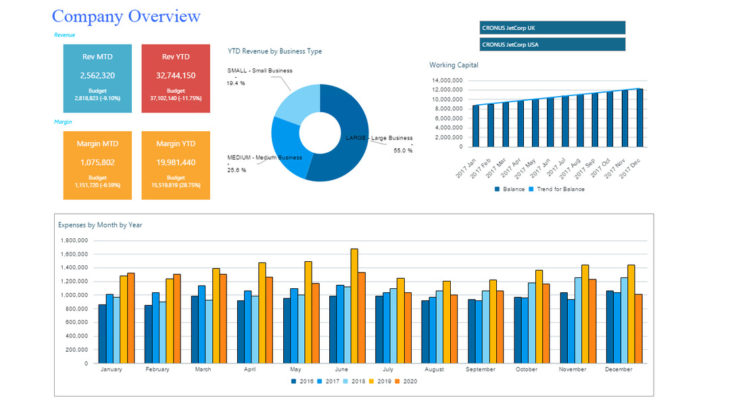Improve Your 2023 BI with Visual Analytics

A picture is worth a thousand words. Most people, if presented with an array of numbers organized in rows and columns, will need to spend some time digesting that information before they can draw reasonable conclusions from it. When you present data visually, on the other hand, conclusions often jump off the page (or off the screen, as it were). At the very least, visual analytics make it easier for most users to get the point quickly and identify key takeaways.
In business, that translates to faster, more accurate insights. It assists leaders in making prompt decisions based on hard data. It also facilitates consensus, making it easier to align the team around a clear conclusion and an appropriate course of action.
Given the amount of business data that most organizations must collect and maintain, it is harder than ever to sift through the background noise and discern the meaningful messages that can guide effective business decisions. A more effective strategy is to represent those data visually, to make them available to the right people in the form of interactive charts, graphs, maps, or other visual representation.
Over the past year, businesses of all sizes have internalized the need for greater agility, that is, the need to scan the environment, identify opportunities and threats on the road ahead, and respond quickly. Visual analytics has become even more critical throughout the past year as a key enabler of business agility because it provides fast access to meaningful information.
Here are some of the distinct ways visual analytics can support leaders to put 2023 on an upward trajectory.
Focus on What Matters Most
Top performers–whether they are individuals or businesses–have the capacity to focus on the things that matter most. In his best-selling book, The Seven Habits of Highly Effective People, author Stephen Covey demonstrates the importance of “putting first things first” by filling a container with “big rocks” and adding smaller stones and sand afterward. There’s plenty of room for all of it in the container. When you perform those tasks in the opposite order, though, there is no room left in the end for the big rocks.
His point? If you allow yourself (or your organization) to focus on the small things, then the bigger, more important priorities will never get done. Because visual analytics are easily accessible and digestible for the entire organization, they provide a meaningful yardstick against which everyone can measure progress toward those “big rocks,” the top priority goals that are truly important to the organization. Graphs and dashboards, updated frequently, provide a clear and concise scoreboard that helps keep everyone focused on the same objectives.
Leverage the Power of Dynamic Data
Data analysis tools have come a long way, even in the past few years. Microsoft Excel, for example, puts tremendous power in the hands of virtually any user to turn rows and columns of numbers into easily digestible graphical information.
Unfortunately, there are significant drawbacks to a purely Excel-based approach. The primary issue is that as a standalone tool, Excel tends to be relatively static. Business data are constantly changing, though. Customers place new orders, suppliers change their prices (or run out of inventory), unexpected costs arise, and so on. Much of those data live in the ERP system, which is constantly updated with new transactions. But, when working with a static Excel spreadsheet, you have to manually update and refresh the data to remain current. This can be a time-consuming, error-prone process that doesn’t provide the agility today’s organizations need.
To achieve agility, businesses need a clear view of what is happening now; they need up-to-the-minute accuracy. Dynamic reporting tools make it possible to get that real-time view of the business by accessing current information in constantly refreshing visual analytics dashboards. That ensures that business leaders have visibility to issues and opportunities as they emerge. The longer the delay between a transactional event and management’s situational awareness, the slower the business will be in responding.
Empower Your Team, Anytime and Anywhere
More than ever, running a business is a 24/7 undertaking. As large portions of the workforce have shifted toward remote work, the four walls of the office workplace have become less meaningful. Working from a home office has become commonplace, but so too has working from virtually anywhere at any time. Mobile devices have made that possible, providing almost universal connectivity.
In the context of that trend, it makes little sense to confine financial and operational reporting to the office workplace. With the right tools, you can extend visual analytics to almost anywhere, even when there is no live connection to the Internet. Visual representations of data are very effective tools for persuasion, whether it’s for a sales meeting with a prospective customer or an internal pitch to align the management team around a new project. Mobility apps ensure that this power of persuasion is available anytime, anywhere.
Bring Your Data to Life
Regardless of which ERP system your organization is running–Oracle, SAP, Microsoft Dynamics, Sage, or one of many others–you know how difficult it can be to get meaningful reports from that system. Most ERP vendors have built multiple reporting tools over the years, each of which has significant drawbacks. Many are clearly calibrated to be “just good enough.” They lack the flexibility and sophistication to provide the kind of powerful, up-to-the-minute information that business managers need in today’s rapidly changing world. They don’t do a good job of representing data visually, or if they support graphical reports at all, they do it poorly.
Other vendors, most notably Microsoft, are promoting extraordinarily complicated platform tools such as Power BI, which require a large-scale implementation project in their own right. The technology investment to get such systems up and running is immense, not to mention the long-term costs associated with creating and modifying reports that require a high degree of technical expertise to maintain.
At insightsoftware, we create powerful tools for visual analytics that are easy to use, empowering frontline business users with the capability to develop and maintain reports and dashboards without the need for programmers or other highly specialized IT consultants. Our products integrate with over 140 different ERP systems, making it easy to access data in real-time for up-to-the-minute information about what’s happening in your business. If you’re interested in bringing the power of visual analytics to your company, contact us today to request a free demo.








